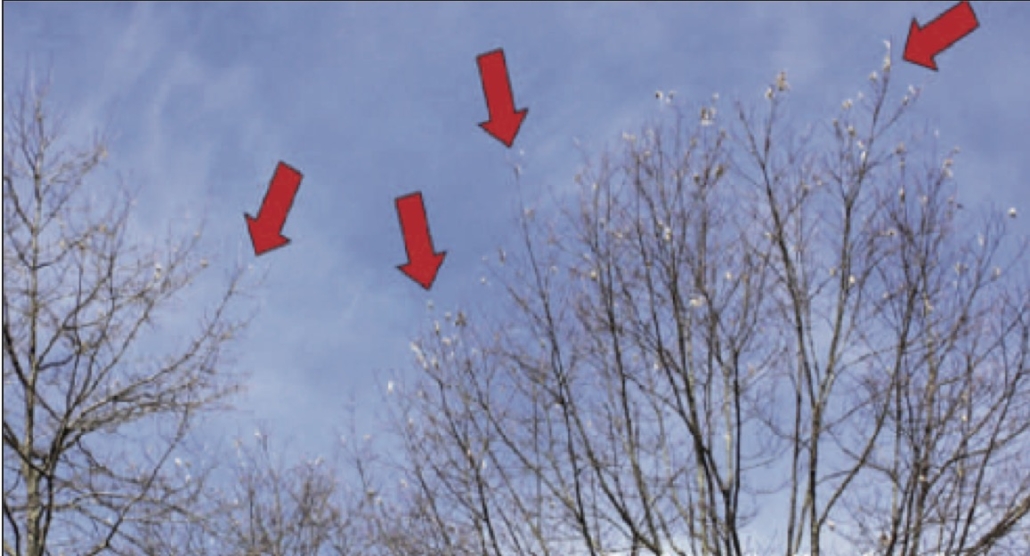SCORES & OUTDOORS: Browntail moth experienced a drastic population decline in 2024

Many browntail moth winter webs at the tips of tree branches in Augusta. (photo courtesy of the Maine Forest Service)
 by Roland D. Hallee
by Roland D. Hallee
I recently received this update from the Maine Forest Service on the status of the browntail moth caterpillar.
Browntail caterpillars will remain in their winter webs for now…
Throughout the winter season in Maine, browntail caterpillars are nestled inside of their winter webs they created in late fall. These winter webs can be found on the tips of the branches of their host trees, typically oak, birch, cherry, crabapple, and other fruit and hardwood trees. Winter webs made by browntail caterpillars have a distinct white silk covering that protects them from the harsh Maine winters.
Now through March is the best time to go out and begin scouting for winter webs on your property. A sunny day makes for a good scouting day, as the white silk of the winter webs will shine back at you – a good indication of a browntail winter web. Sometimes, oak and hawthorn trees hold onto marcescent leaves, which are dead leaves that haven’t yet fallen off the tree, which can be confused for browntail webs.
Maine Forest Service surveys cannot be exhaustive. The most important populations of browntail moth that may affect your daily life in the spring and summer may not be found by these surveys.
Browntail moth experienced a drastic population reduction in 2024. That means aerial survey only highlighted scattered small areas of concern. Trace to moderate populations may be found throughout a large area of the state. Small numbers of webs can produce enough caterpillars to cause an itchy spring and summer.
By recognizing webs in winter, you can respond to their presence and reduce impacts in spring and summer.
Scouting for webs is an important first step in understanding browntail moth populations your backyard.
Pick a sunny day for scouting to make the webs easier to spot.
Prioritize trees that surround your home, driveway, porch, play areas, etc.
Consider scouting for winter webs around your business, especially in areas where browntail moth caterpillars may emerge from winter webs in the spring and crawl onto vehicles (such as parking lots), or impact outdoor activities (such as picnic/break areas, near walkways and buildings, etc.)
Stand with your back to the sun about 50-100 ft. away from the base of the trees.
You may want to stand closer if scouting for webs on shorter, ornamental trees.
Check for clumps of leaves at the tips of branches.
On cloudy days, these leaves may appear brown or gray, but on sunny days, you’ll be able to see a white silk covering on these leaves.
Browntail winter webs will not be larger than the palm of your hand (roughly 3 – 5 inches long) and are typically narrow in width.
In heavily infested trees (trees with 100+ winter webs), like the ones in the enclosed photo, winter web removal may not be appropriate. Instead, pesticide applications may be considered if these trees are in a high-traffic area such as your dooryard or the front of your business building.
If you can’t remove the browntail winter webs on your property, consider hiring a professional to assist with removal. Winter web removals should be completed before the end of March.
What we’re working on this winter:
Browntail populations have declined in 2024. To understand the full extent of the reduction in browntail, we will continue our winter web survey starting in January 2025. These surveys are usually completed in March. After the data is reviewed, it will appear on our interactive browntail moth dashboard, which will give you a rough idea about what browntail is doing in your community.
A Patriots observation
The NFL season has ended for the New England Patriots with a 4-13 record. Here’s my quick analysis of the season. They began the year with an upset win over the Cincinnati Bengals, 20-16. They ended the season with another upset victory, 23-16, over the Buffalo Bills. Comparing the two scores, I see a 13.1 percent improvement, from beginning to end. We won’t discuss what happened in between.
Roland’s trivia question of the week:
Name the four NFL teams that have a human face in their logo.













